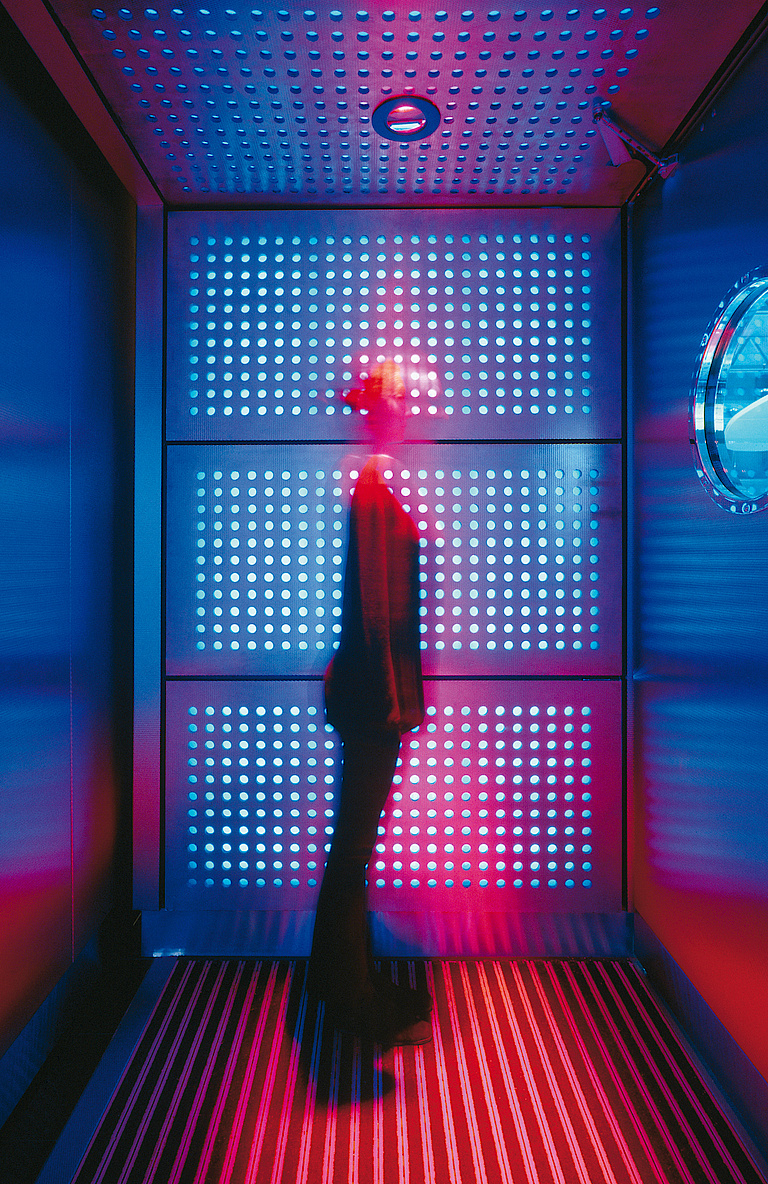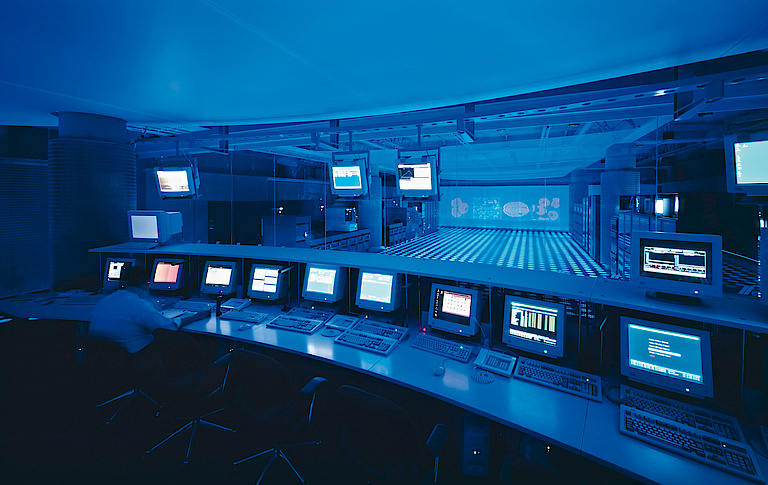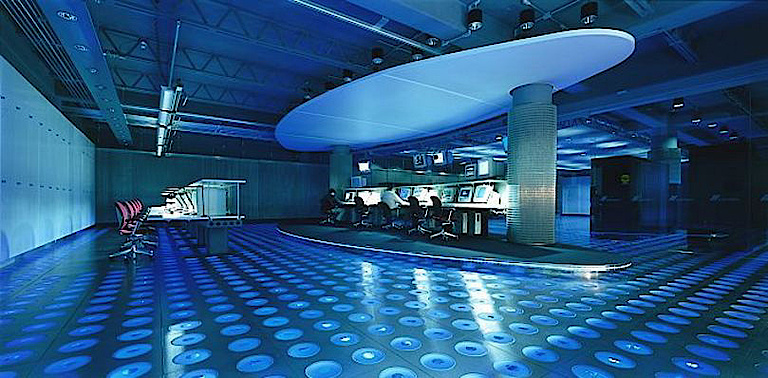Cemex Monterrey Mexico - Grimshaw









Hal 9000 Cemex Computer Centre
Monterrey, Mexico
Grimshaw Architects, London
Hal 9000 is a computer centre in Monterey, Mexico designed for Cemex; one of the most important cement producers in Mexico. The brief asked for the design of a futuristic interior to reflect the image and vision of the company and to impress important clients and visitors. The new building consists of a one storey high white box with only a few windows in the office area. Due to the climate of Mexico and the function of the building a highly controlled environment was requested and total security and flexibility for future demands were also priorities. The computer centre operates, co-ordinates and controls the whole of the company's global production, stock and distribution and is in operation 24 hours a day, 365 days a year.
One of the most interesting challenges of the project was to define the use of different areas : to design a very special environment for each room based on its function. A visitor to Hal 9000 will experience very different spaces whilst moving through the building, much like a theatrical set. The lighting of the space plays a key role in the design approach. A computer program has been set up for two very different lighting scenarios: one for the regular day to day use and one for the special VIP visits.
Due to the very strict security, all visitors have to pass through a special security lock before finally entering the centre. As soon as access clearance has been given, the heavy 3.00 x 3.00m stainless steel sliding door will open for the visitor to enter a small enclosed space. The space will only be lit by indirect blue lighting through the perforations in the stainless steel lining of the door. The visitors will step in and the door will close whilst red gobos recessed in the ceiling illuminate, giving the impression of scanning the visitor. Only when the sliding door is completely closed will the second set of doors opposite automatically open to allow access to the computer centre.
The blue light etched glass lenses in the floor will express an atmosphere of an 'ice house' reflecting this heavily controlled environment for the highly sophisticated computer technology. The raised access floor with a cavity of 600 mm has been constructed of standard 600 x 600 mm floor tiles covered in pattered stainless steel with 4 circular cut outs filled with etched glass lenses with a clear circle in the middle. Through the circle of clear glass can be seen the thousands of cables acting as the nerves of the computer centre. The total area of the void below has been installed with standard fluorescents covered in blue gel. The etched glass lenses diffuse the light and give the space this icy cool atmosphere relating to the high level of temperature control.
The control desk - the 'eye' of the whole operation - overlooks the computer area from a raised elliptical platform only separated by a full height glass screen. The staff at the control desk work on a carpeted island below a highly translucent textile ceiling providing warm indirect glare-free light for this highly computerised working area. The computer room will generally only be lit by the blue lighting in the floor. If a problem arises and a member of staff has to enter the space through one of the access controlled glass sliding doors, lights in the ceiling will be activated by a movement sensor to provide a sufficient lighting level in the area required. Once this operation is completed and movement is no longer detectable, the lights automatically switch off.
The two long side walls and structural columns have been unified by stainless steel mesh cladding suspended from the concrete beams of the slab above to hide all structural columns and services. Stainless steel mesh of a different pattern has been suspended from the slab as a suspended ceiling to hide services. The stainless steel mesh on the walls, columns and ceiling reflects the blue light of the floor.
The end wall opposite the control desk shows a white tensioned sail wall, suspended from the slab. The wall can be used as a projection screen for presentations to clients and also provides a visual focus point for the control desk operators suffering from computer screen fatigue.
Monterrey, Mexico
Grimshaw Architects, London
Hal 9000 is a computer centre in Monterey, Mexico designed for Cemex; one of the most important cement producers in Mexico. The brief asked for the design of a futuristic interior to reflect the image and vision of the company and to impress important clients and visitors. The new building consists of a one storey high white box with only a few windows in the office area. Due to the climate of Mexico and the function of the building a highly controlled environment was requested and total security and flexibility for future demands were also priorities. The computer centre operates, co-ordinates and controls the whole of the company's global production, stock and distribution and is in operation 24 hours a day, 365 days a year.
One of the most interesting challenges of the project was to define the use of different areas : to design a very special environment for each room based on its function. A visitor to Hal 9000 will experience very different spaces whilst moving through the building, much like a theatrical set. The lighting of the space plays a key role in the design approach. A computer program has been set up for two very different lighting scenarios: one for the regular day to day use and one for the special VIP visits.
Due to the very strict security, all visitors have to pass through a special security lock before finally entering the centre. As soon as access clearance has been given, the heavy 3.00 x 3.00m stainless steel sliding door will open for the visitor to enter a small enclosed space. The space will only be lit by indirect blue lighting through the perforations in the stainless steel lining of the door. The visitors will step in and the door will close whilst red gobos recessed in the ceiling illuminate, giving the impression of scanning the visitor. Only when the sliding door is completely closed will the second set of doors opposite automatically open to allow access to the computer centre.
The blue light etched glass lenses in the floor will express an atmosphere of an 'ice house' reflecting this heavily controlled environment for the highly sophisticated computer technology. The raised access floor with a cavity of 600 mm has been constructed of standard 600 x 600 mm floor tiles covered in pattered stainless steel with 4 circular cut outs filled with etched glass lenses with a clear circle in the middle. Through the circle of clear glass can be seen the thousands of cables acting as the nerves of the computer centre. The total area of the void below has been installed with standard fluorescents covered in blue gel. The etched glass lenses diffuse the light and give the space this icy cool atmosphere relating to the high level of temperature control.
The control desk - the 'eye' of the whole operation - overlooks the computer area from a raised elliptical platform only separated by a full height glass screen. The staff at the control desk work on a carpeted island below a highly translucent textile ceiling providing warm indirect glare-free light for this highly computerised working area. The computer room will generally only be lit by the blue lighting in the floor. If a problem arises and a member of staff has to enter the space through one of the access controlled glass sliding doors, lights in the ceiling will be activated by a movement sensor to provide a sufficient lighting level in the area required. Once this operation is completed and movement is no longer detectable, the lights automatically switch off.
The two long side walls and structural columns have been unified by stainless steel mesh cladding suspended from the concrete beams of the slab above to hide all structural columns and services. Stainless steel mesh of a different pattern has been suspended from the slab as a suspended ceiling to hide services. The stainless steel mesh on the walls, columns and ceiling reflects the blue light of the floor.
The end wall opposite the control desk shows a white tensioned sail wall, suspended from the slab. The wall can be used as a projection screen for presentations to clients and also provides a visual focus point for the control desk operators suffering from computer screen fatigue.

